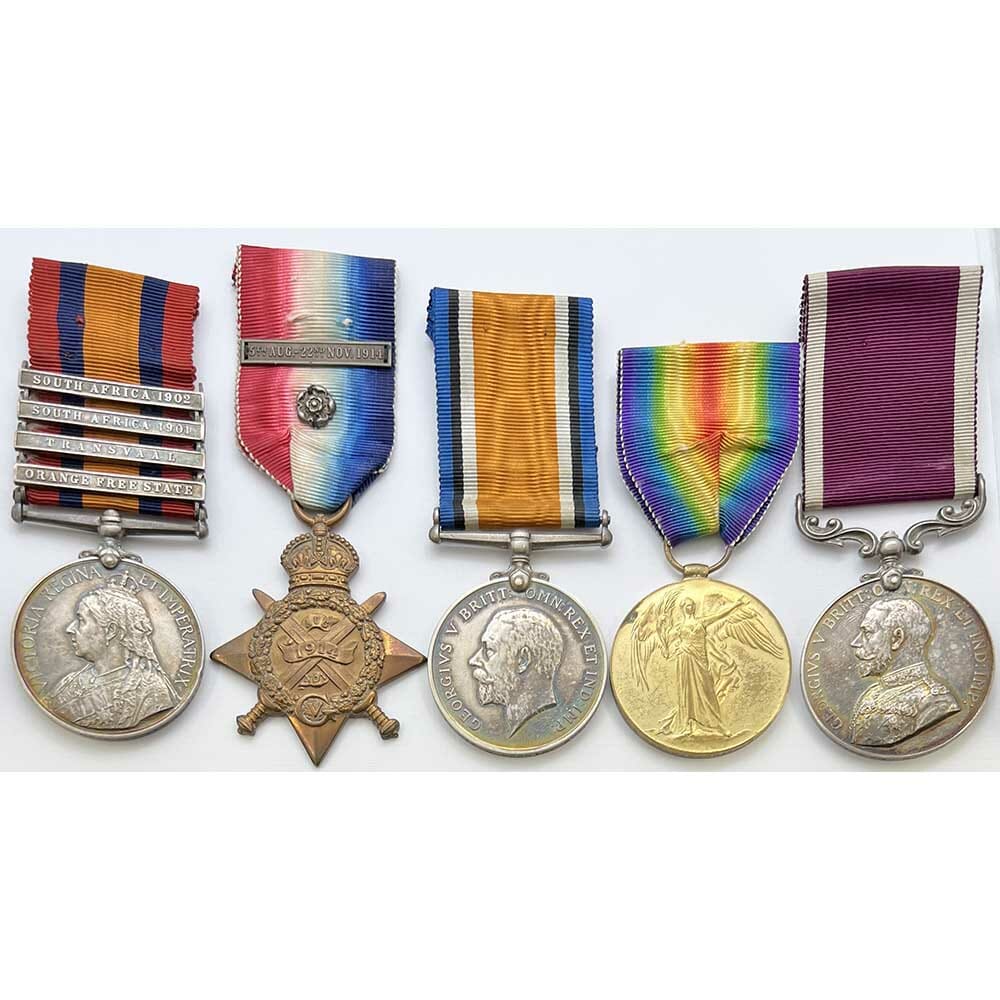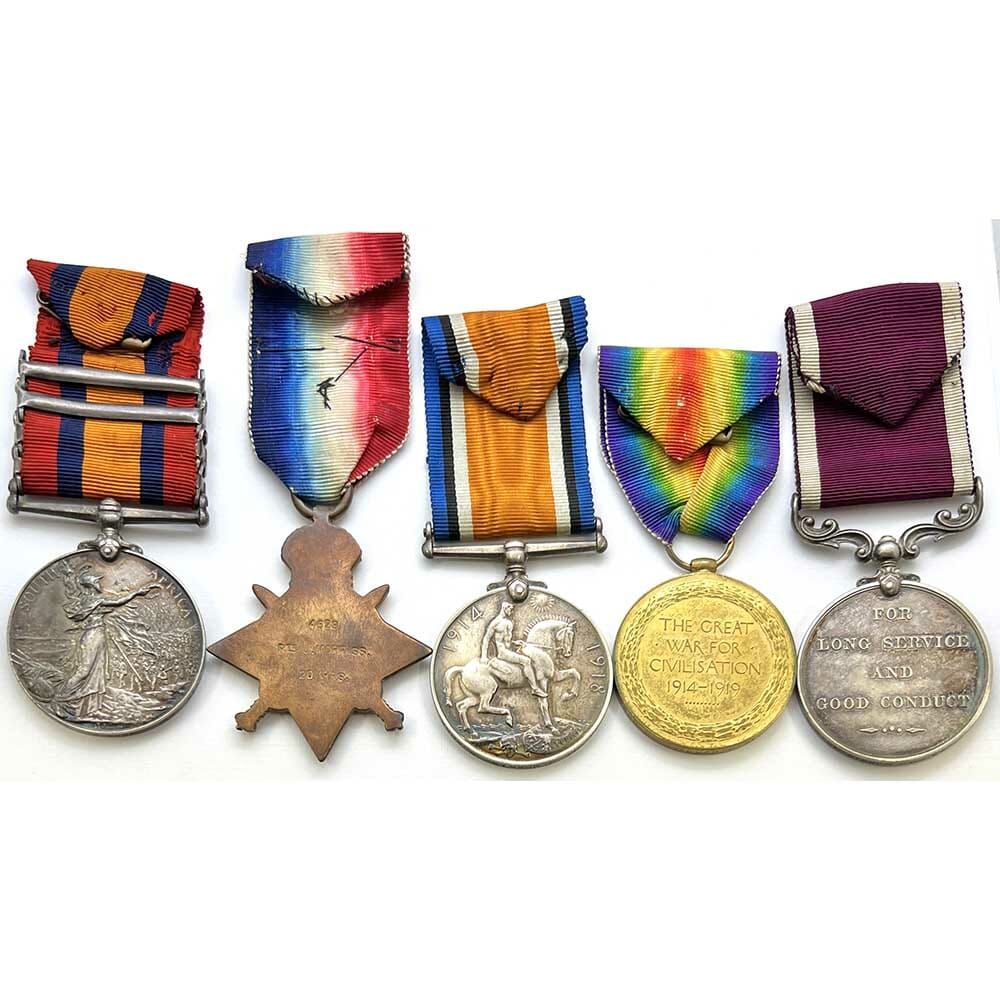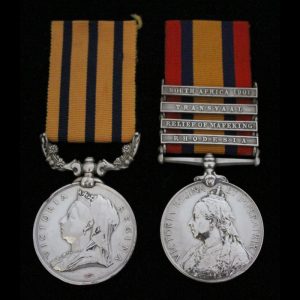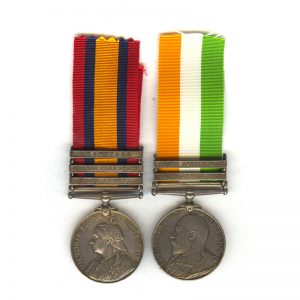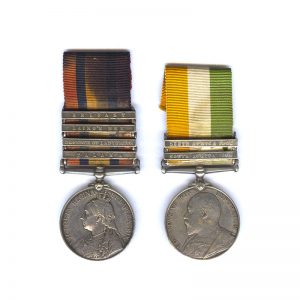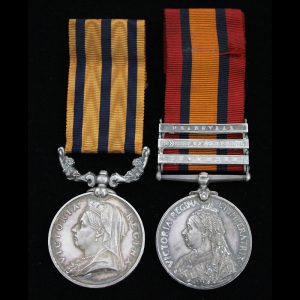Description
Queen’s South Africa Medal, 4 bars, Orange Free State, Transvaal, South Africa 1901, South Africa 1902, 1914 Star Trio, with original Mons Clasp, Army L.S.G.C., 4529 Private John Morris, 20th Hussars.
QSA officially impressed: “4529 Pte. J. Morris. 20th Hussars”
1914 Star impressed: “4529 Pte J. Morriss. 20/Hrs” With original sewn on “Mons” clasp, and silver rosette
BWM Victory Pair impressed: “4529 Pte. J. Morris. 20-Hrs”
LSGC impressed: “H-47644 Pte J. Morris. 20/Hrs:”
Admitted to hospital at Rouen on 2nd July 1916, having received a Gunshot Wound to the left Arm. The next day he was invalided back to England from Rouen on Hospital Ship St David.
Awarded his Army LS and GC Medal at Tidworth, 22nd October 1918.
John Morris, was born in Aberdeen, Scotland circa 1876.
He first attested for service aged 22 at Warwick, having been a Groom, for service with the 20th Hussars on 4th November 1899.
Saw the following overseas service:
India, 14th Dec 1900 – 12th Dec 1901
South Africa, 13th Dec 1901 – 17th April 1903
Egypt, 18th April 1903 – 14th Dec 1904
B.E.F., 15th August 1914 – 9th July 1919
E.E.F. (Egyptian Expeditionary Force) served in Palestine, 10th July 1919 – 28th June 1920,
Black Sea, 29th June 2910 to 17th Nov 1920.
During this time in the “Black Sea” the 20th Hussars were dispatched to Turkey where they were said to have taken part in the final full scale Cavalry Charge against Turkish Nationalist Rebels during the Turkish War of Independence.
“A nationalist uprising in Turkey caused the allies to send troops to Constantinople. The Regiment as deployed to the Izmit Peninsula in 1920 as part of a formation under General Sir Edmund Ironside’s Command. The regiment charged Turkish positions in July near the village of Gebze and successfully routed the enemy.
Although mounted action did take place in Syria during the 2nd World War, this was the last regimental charge made by British Cavalry.”
“Shortly after the Regiment arrived, the Nationalists severed communications with the Peninsular, blowing up its bridge. A small battle group, including the 20th Hussars was sent to dislodge them on the morning of 13th July 1920.
The Regiment ‘2 Squadrons abreast in columns of troops with the 3rd squadron in depth’ broke the skyline of a ridge 1,000 yards from the enemy’s right flank and attacked immediately, the trumpeters sounding first the Trop, then the Canter, and finally the Charge. Swords fully extended the 20th Hussars struck the Turks at full gallop, sending them sprawling or cutting them down. The Regiment rode straight through the enemy, rallied re-formed and charged again.
The Turks however had had enough and soon dispersed. Although not realised at the time, this was to prove the last regimental charge ever made by British Cavalry.”
He served with the Regiment in the Boer War, they were present in the last year of the war, arriving at Durban in December 1901.
The regiment served alongside the 3rd Hussars under Colonel Nixon, taking part in operations in the extreme Northeast of the Orange River Colony during the final drives of the war, as the Army chased down the tenacious remaining Boers who still evaded capture.
By 10th August 1907, his 12 years had come up for renewal, choosing to extend his service for another 5 years, again re-engaging on 16th March 1911.
When WW1 Broke out, the Cavalry was immediately sent over, his Medal Index Card noting his arrival in France on 16th August 1914, where they would take part in a mounted patrol on 22nd August 1914 and take part in the early battles of the war.
After the retreat from Mons the regiment would take part in providing mounted duties including reconnoitring and acting as advanced guard in the early stages of the war before the 1st Battle of Ypres when Trench Warfare took over.
At the Battle of the Somme, the regiment was dismounted and acting as a mobile reserve, taking part in miming parties for the blowing up of the Messines Ridge.
On the disastrous 1st Day of the Somme, he was attached to the 26th Service Battalion, Northumberland Fusiliers (3rd Tyneside Irish) who suffered many casualties on the day.
The next day he was taken into hospital, having received a Gunshot Wound to the left arm.
He later joined the 5th Reserve Regiment of Cavalry on 12th February 1917, after the war he went with the regiment to Palestine and on to Turkey, where they fought against the Turkish Nationalists, and after returning home was later discharged form Tank Corps
